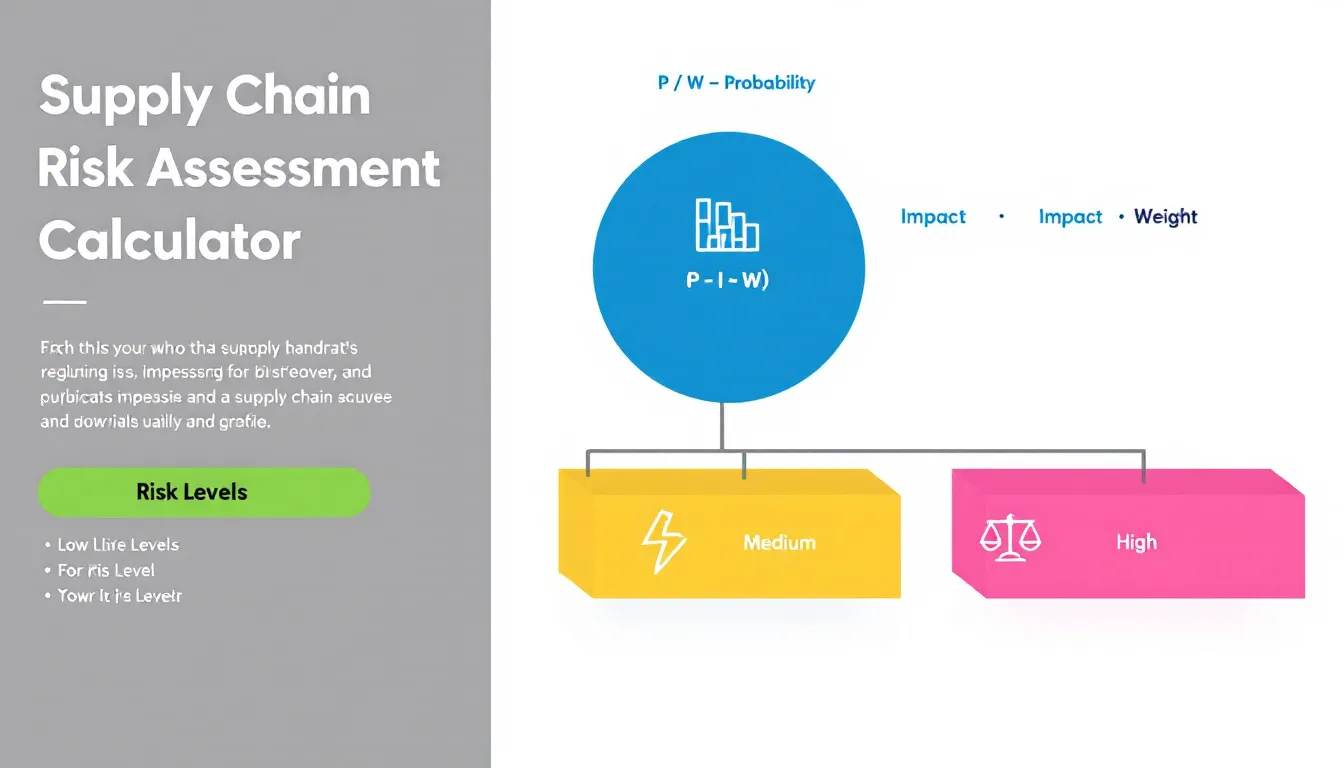Supply Chain Risk Assessment Calculator
Is this tool helpful?
How to Use the Supply Chain Risk Assessment Calculator Effectively
To utilize this comprehensive supply chain risk assessment tool, follow these steps:
- Enter Risk Factor Name: Input a descriptive name for each risk factor (e.g., “Raw Material Shortage” or “Transportation Strike”)
- Set Probability: Enter the likelihood of occurrence as a percentage (0-100%). For instance, a cyber-security breach might have a 15% probability, while weather-related disruptions could have a 40% probability
- Define Impact Severity: Rate the potential impact on a scale of 1-10, where 1 represents minimal disruption and 10 indicates catastrophic consequences
- Assign Weight Factor: Optionally, specify a weight between 0.1 and 5 to prioritize certain risks over others
Understanding Supply Chain Risk Assessment
Supply chain risk assessment is a critical process that helps organizations identify, evaluate, and mitigate potential threats to their supply chain operations. This calculator employs a sophisticated risk scoring methodology based on the following formula:
$$Risk Score = P \times I \times W$$Where:
- P = Probability of occurrence (0-1)
- I = Impact severity (1-10)
- W = Weight factor (0.1-5)
Total Risk Score Calculation
$$Total Risk Score = \sum_{i=1}^{n} (P_i \times I_i \times W_i)$$Benefits of Using the Supply Chain Risk Assessment Calculator
- Quantitative Risk Analysis: Transform qualitative assessments into measurable metrics
- Visual Risk Representation: Interactive charts and graphs for better decision-making
- Standardized Evaluation: Consistent risk assessment methodology across the organization
- Priority-based Planning: Identify and focus on high-impact risk factors
- Resource Optimization: Allocate resources effectively based on risk levels
Addressing Supply Chain Vulnerabilities
The calculator helps organizations tackle various supply chain challenges:
Risk Level Classification
- Low Risk (≤ 3): Routine monitoring and standard controls
- Medium Risk (3-6): Enhanced monitoring and preventive measures
- High Risk (> 6): Immediate attention and strategic intervention
Sample Risk Assessment Scenario
Consider a manufacturing company evaluating three risk factors:
- Component Shortage: P=0.35, I=8, W=1.2 $$Risk Score = 0.35 \times 8 \times 1.2 = 3.36$$
- Quality Control Issues: P=0.25, I=7, W=1.5 $$Risk Score = 0.25 \times 7 \times 1.5 = 2.625$$
- Logistics Disruption: P=0.45, I=6, W=1.0 $$Risk Score = 0.45 \times 6 \times 1.0 = 2.7$$
Practical Applications and Use Cases
Manufacturing Industry
- Evaluating supplier reliability
- Assessing production line vulnerabilities
- Analyzing quality control risks
Retail Sector
- Inventory management risk assessment
- Distribution network evaluation
- Seasonal demand fluctuation analysis
Healthcare Supply Chain
- Medical supply availability assessment
- Temperature-controlled logistics risk evaluation
- Regulatory compliance risk analysis
Frequently Asked Questions
What factors should I consider when naming risk factors?
Use clear, specific names that accurately describe the risk. For example, instead of “Delivery Problem,” use “International Shipping Delay” or “Last-Mile Delivery Disruption.”
How do I determine the appropriate impact severity rating?
Consider factors such as financial impact, operational disruption, customer satisfaction, and recovery time. A severity of 8-10 should be reserved for risks that could potentially halt operations.
When should I use weight factors?
Apply weight factors when certain risks have heightened importance due to business strategy, seasonal factors, or market conditions. For example, assign higher weights to risks affecting core product lines.
How often should I update my risk assessment?
Regular quarterly assessments are recommended, with additional evaluations following significant supply chain changes or market events.
Can I compare risk assessments across different departments?
Yes, the standardized scoring system allows for meaningful comparisons across departments, facilities, or supply chain segments.
How should I interpret the risk distribution chart?
The chart visualizes the relative contribution of each risk factor to your total risk profile, helping identify areas requiring immediate attention.
What actions should I take based on the recommendations?
Develop action plans aligned with the risk levels identified. High-risk areas require immediate mitigation strategies, while medium-risk areas need preventive measures and monitoring.
Advanced Features and Capabilities
Risk Trend Analysis
Track changes in risk scores over time to identify patterns and emerging threats. This historical perspective enables proactive risk management and strategy refinement.
Customizable Risk Categories
Group related risks into categories such as:
- Operational Risks
- Financial Risks
- Environmental Risks
- Compliance Risks
- Market Risks
Interactive Visualization
The calculator provides dynamic charts and graphs that update in real-time as you input data, offering immediate visual feedback on your risk profile.
Best Practices for Risk Assessment
Data Collection
- Gather historical data on past incidents
- Consult industry reports and trends
- Include input from key stakeholders
- Consider geographical and seasonal factors
Risk Evaluation Process
- Review and update assessments regularly
- Document assumptions and rationale
- Validate findings with subject matter experts
- Consider interconnected risks
Important Disclaimer
The calculations, results, and content provided by our tools are not guaranteed to be accurate, complete, or reliable. Users are responsible for verifying and interpreting the results. Our content and tools may contain errors, biases, or inconsistencies. Do not enter personal data, sensitive information, or personally identifiable information in our web forms or tools. Such data entry violates our terms of service and may result in unauthorized disclosure to third parties. We reserve the right to save inputs and outputs from our tools for the purposes of error debugging, bias identification, and performance improvement. External companies providing AI models used in our tools may also save and process data in accordance with their own policies. By using our tools, you consent to this data collection and processing. We reserve the right to limit the usage of our tools based on current usability factors.







